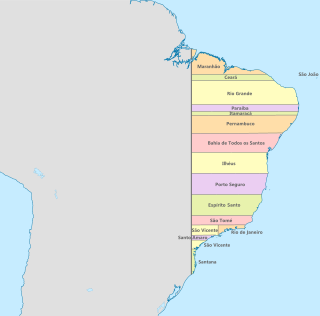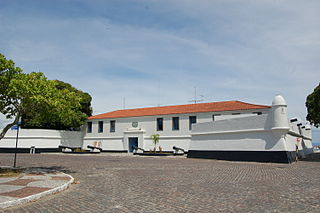Related Research Articles

The Dutch West India Company or WICDutch pronunciation:[ʋɛstˈɪndisəkɔmpɑˈɲi] was a chartered company of Dutch merchants as well as foreign investors, formally known as GWC. Among its founders were Reynier Pauw, Willem Usselincx (1567–1647) and Jessé de Forest (1576–1624). On 3 June 1621, it was granted a charter for a trade monopoly in the Dutch West Indies by the Republic of the Seven United Netherlands and given jurisdiction over Dutch participation in the Atlantic slave trade, Brazil, the Caribbean, and North America.

Piet Pieterszoon Hein was a Dutch admiral and privateer for the Dutch Republic during the Eighty Years' War. Hein was the first and the last to capture a large part of a Spanish treasure fleet which transported huge amounts of gold and silver from Spanish America to Spain. The amount of silver taken was so large that it resulted in the rise of the price of silver worldwide and the near bankruptcy of Spain.

Michiel Adriaenszoon de Ruyter was a Dutch admiral. His achievements with the Dutch Navy during the Anglo-Dutch Wars earned him the reputation as one of the most skilled naval commanders in history.

John Maurice of Nassau, called "the Brazilian" for his fruitful period as governor of Dutch Brazil, was Count and Prince of Nassau-Siegen. He served as Herrenmeister of the Order of Saint John from 1652 until his death in 1679.

The Battle of the Downs took place on 21 October 1639, during the Eighty Years' War. A Spanish fleet, commanded by Admiral Antonio de Oquendo, was decisively defeated by a Dutch force under Lieutenant-Admiral Maarten Tromp. Victory ended Spanish efforts to re-assert naval control over the English Channel and confirmed Dutch dominance of the sea lanes, while it is also alleged to be the first major action to feature line of battle tactics.

The Second Battle of Guararapes was the second and decisive battle in a conflict called the Insurrection of Pernambuco, between Dutch and Portuguese forces in February 1649 at Jaboatão dos Guararapes in Pernambuco. The defeat convinced the Dutch "that the Portuguese were formidable opponents, something which they had hitherto refused to concede." The Dutch still retained a presence in Brazil until 1654 and a treaty was signed in 1661.

Dutch Brazil, also known as New Holland, was a colony of the Dutch Republic in the northeastern portion of modern-day Brazil, controlled from 1630 to 1654 during Dutch colonization of the Americas. The main cities of the colony were the capital Mauritsstad, Frederikstadt, Nieuw Amsterdam (Natal), Saint Louis, São Cristóvão, Fort Schoonenborch (Fortaleza), Sirinhaém, and Olinda.

Cornelis Corneliszoon Jol, nicknamed Houtebeen ("pegleg"), was a 17th-century Dutch corsair and admiral in the Dutch West India Company during the Eighty Years' War between Spain and the Dutch Republic. He was one of several early buccaneers to attack Campeche, looting the settlement in 1633, and was active against the Spanish in the Spanish Main and throughout the Caribbean during the 1630s and 40s.

Loango-Angola is the name for the possessions of the Dutch West India Company in contemporary Angola and the Republic of the Congo. Notably, the name refers to the colony that was captured from the Portuguese between 1641 and 1648. Due to the distance between Luanda and Elmina, the capital of the Dutch Gold Coast, a separate administration for the southern districts of Africa was established at Luanda during the period of the Dutch occupation.

The Flag of New Holland, also known as the flag of Dutch Brazil, was the flag used by the Dutch West India Company for the territories that were under its control in Brazil from 1630 until 1654. In this period, Brazil was not granted its own flag, and only the flags of its colonizers or rulers were used.

Johan Evertsen de Liefde was a Dutch naval commander who served as vice admiral of Holland and West Frisia within the Admiralty of Rotterdam. His elder brother, Cornelis de Liefde, was also a naval commander. Johan was killed in the battle of Texel.

The recapture of Bahia was a Spanish–Portuguese military expedition in 1625 to retake the city of Bahia in Brazil from the forces of the Dutch West India Company (WIC).

The capture of Salvador was a military engagement between Portugal and the Dutch West India Company, that occurred in 1624, and ended in the capture of the Brazilian city of Salvador by the latter. This capture was part of the Groot Desseyn plan of the Dutch West India Company. Although the Dutch intentions were reported to the Spanish no preventive counter-action was taken by them.
The action of 12–17 January 1640 was a naval battle between a Dutch fleet and a combined Spanish-Portuguese fleet during the Eighty Years' War. The battle took place on the Brazilian coast off Pernambuco and was an attempt by a fleet consisting of approximately eighty vessels transporting about 5,000 soldiers under the command of Portuguese Admiral Fernando de Mascarenhas to land reinforcements to bolster the Portuguese militia besieging the city of Recife. On 12 January this fleet was intercepted by a Dutch task force of about forty ships commanded by Willem Loos. The ensuing battle lasted with occasional breaks until the evening of 17 January, when the Spanish and Portuguese fleet retreated and sailed away to the north.

The Captaincy of Pernambuco or New Lusitania was a hereditary land grant and administrative subdivision of northern Portuguese Brazil during the colonial period from the early sixteenth century until Brazilian independence. At the time of the Independence of Brazil, it became a province of United Kingdom of Portugal, Brazil and the Algarves. Captaincies were originally horizontal tracts of land (generally) 50 leagues wide extending from the Atlantic Ocean to the Tordesillas meridian.

The siege of Salvador was a siege that took place between April and May 1638, during the Dutch–Portuguese War and Eighty Years' War. The governor of the Dutch colony in Brazil, John Maurice, Prince of Nassau-Siegen, commanding the army of the Dutch West India Company, with vastly superior forces and a supporting fleet under Johan van der Mast, put the city of Salvador under siege. The Portuguese and Spanish defenders, commanded by Giovanni di San Felice, Count of Bagnolo, and Luís Barbalho, managed to resist the Dutch attacks until they gave up taking the city and withdrew with several casualties.

São Marcelo Fort, also known as Forte de Nossa Senhora do Pópulo e São Marcelo or Forte do Mar, is located in Salvador in Bahia, Brazil. It is located in small bit of land off the coast in the Baía de Todos os Santos. Standing on a small bank of reefs about 300 metres (980 ft) from the coast, it is one of two forts separated by water from land in Brazil, the other being the Fort Tamandaré da Laje Tamandaré in Rio de Janeiro. It is the only cylindrical fort in Brazil. Its design follows those of Castel Sant'Angelo in Italy and São Lourenço do Bugio Fort in Portugal. It is popularly known as the "Forte do Mar". It was built to protect the important port city Salvador from threats; the city had the largest number of forts during the colonial period of Brazil.

Forte de São Lourenço is a fort located in Itaparica, Bahia in Brazil. It sits on a strategic point at the north of Itaparica Island on a site used for whaling in the early 17th century. The Dutch constructed a small earthwork fortification on the site during the Dutch occupation of Brazil (1630–1654); it was reconstructed by the Portuguese in its present form in the early 18th century. The fort was used by Brazilian forces during the Brazilian struggle for independence in 1823; the Brazilian Navy has owned the fort since the same year. The Forte de São Lourenço was listed as a federal historic structure in 1938.

The Conquest of Paraíba refers to the attempts by Dutch forces in 1630 to seize control of Paraíba, Brazil, from the Portuguese, mainly for the lucrative sugar cane market.

The Dutch invasions in Brazil, ordered by the Dutch West India Company (WIC), occurred during the 17th century.
References
- ↑ "Maritieme kalender", Nationaal Scheepvaartmuseum (Dutch)
- ↑ Robert Brock Le Page and Andrée Tabouret-Keller, Acts of identity: Creole-based approaches to language and ethnicity, CUP Archive, 1985
- ↑ . H.J.M. Nellen and Cornelia M. Ridderikhoff (eds.), Briefwisseling van Hugo Grotius, Vol. 13, Martinus Nijhoff, The Hague, 1990 (Dutch)
- ↑ Marley, David F. (2008-02-11). Wars of the Americas [2 volumes]: A Chronology of Armed Conflict in the Western Hemisphere [2 volumes]. Bloomsbury Publishing USA. p. 204. ISBN 978-1-59884-101-5.
- ↑ "Lighthart (Johan)" in A.J., Van der Aa., Biographisch Woordenboek der Nederlanden (Dutch)
- ↑ Robert Southey, History of Brazil, Oxford University, 1817, p. 189